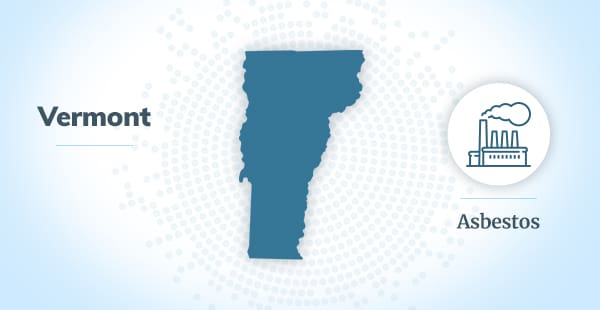01. Vermont Asbestos Use
Asbestos Use in Vermont
Vermont was one of the first states in the country that mined asbestos. As a result, Vermont mine workers may have experienced asbestos exposure. Workers’ families may have experienced secondary exposure from fibers on miners’ clothes.
This harmful mineral was also popular in other industries and asbestos products. Many Vermont sites, like power plants and paper mills, once used asbestos materials. This put people at risk of asbestos exposure and the development of mesothelioma.
Vermont Asbestos Statistics
Vermont’s lengthy history with asbestos began in 1823. Some of its natural asbestos deposits, like those on Belvidere Mountain, were mined for this mineral. Once extracted, mining companies sold it across the United States. By the mid-1900s, the mine at Belvidere was the largest producer of chrysotile asbestos in the country.
These activities, among others, have led to asbestos exposure for many people in Vermont.
- The United States Geological Survey (USGS) lists 22 known Vermont asbestos sites, including 3 former mines.
- From 1999 to 2020, 150 Vermont residents were diagnosed with mesothelioma.
- Those same years, there were 124 mesothelioma deaths in Vermont.
- Vermont’s mesothelioma mortality rate is higher than the national average.
Mesothelioma patients in Vermont have treatment and legal resources available nearby. For instance, mesothelioma specialists work at the University of Vermont Cancer Center in Burlington.
Anyone who experiences asbestos exposure is at risk of developing mesothelioma cancer. People should tell their doctors if they think they were exposed to asbestos. Doctors may perform screenings and monitor for symptoms of asbestos diseases.
02. Asbestos in Workplaces
Occupational Asbestos Use in Vermont
Many Vermont workers and residents have faced risks of asbestos exposure at work, home and other places.
In general, asbestos mine workers had a high risk of occupational asbestos exposure. Vermont was a prominent location for asbestos mining. Anyone who worked at an asbestos mine here may have inhaled or ingested the minerals’ fibers during typical work activities.
Asbestos also develops near other minerals, like talc. Non-asbestos miners may have faced exposure from cross-mineral contamination. Workers in other occupations were also at risk of asbestos exposure. Many industrial plants and facilities commonly used asbestos materials.
Vermont residents may also experience non-occupational exposure. Building materials for homes and schools made before the 1980s often contain asbestos. If these materials become damaged or undergo repairs, anyone nearby may be exposed.
Asbestos Mining
Vermont was home to the first commercial asbestos mine in the United States. Asbestos was first discovered on Belvidere Mountain around 1823. By 1901, multiple mines opened on either side of the mountain. Over the years, ownership of the mines changed hands. Many asbestos companies, like Ruberoid / GAF Corporation and New England Asbestos Mining and Milling, owned these mining operations.
By the 1970s, the dangers of asbestos were becoming public knowledge. Despite this, the Vermont Asbestos Group (VAG) bought the mine in 1976 and continued operations until its closure in 1993. During its closure process, tons of asbestos waste and debris were left behind. These materials created further risk of asbestos exposure.
Power Plants
Boilers and generators are common components of power plants. These machines create high temperatures and may combust or cause fires. To help protect against fire danger, they were commonly made with asbestos.
Many workers may have been exposed to asbestos through power plant machinery. Asbestos was often used in the construction of power plant facilities and protective clothing, too. Vermont power plants put many workers at risk of exposure. Known asbestos power plant companies include the Vermont Electric Power Company Inc. and Montpelier and Barre Light and Power Company.
Schools
For decades, thousands of schools were built with asbestos construction materials, like asbestos insulation. The University of Vermont in Burlington is one of these schools. As schools age, these materials may become broken down and damaged. This condition increases the risk of asbestos fibers becoming airborne.
Some asbestos laws aim to protect students, teachers and other school staff. But in schools like the University of Vermont, exposure is an ongoing risk.
Paper Mills
The paper industry regularly used asbestos-containing materials in its facilities, equipment and machinery. Equipment like drying machines and sandpaper backing often contained the mineral. Many mills were also constructed with asbestos building materials.
Some paper mill companies in Vermont may have used asbestos. Notable examples include Green Mountain Paper and White Mountain Paper Company. Employees at these mills may have been exposed to asbestos while working.
03. Superfund Sites
Asbestos Superfund Sites in Vermont
The Environmental Protection Agency (EPA) Superfund list does not list any asbestos sites in Vermont. The EPA Superfund list is selective with the sites it adds. This doesn’t mean Vermont sites, like Belvidere Mountain, are free from asbestos risks.
Many in the state lobbied for the former asbestos mine to be included. When it was not approved, residents in Vermont took action against the mine owners to properly clean the site.
Belvidere Mountain Mine
The Belvidere Mountain Mine opened in 1901, 78 years after asbestos was discovered. It operated until the VAG closed it in 1993. When vacating the mine, tons of asbestos waste was left behind. In one record, the EPA noted one pile of mineral residue nearly 400 feet high. For years, EPA investigations of the site evaluated the contamination. Various agencies in Vermont also performed investigations.
In the early 2000s, the EPA considered adding the former mine to the Superfund list. But negotiations remained at a standstill. The EPA, Vermont agencies and a former owner of the mine had already paid millions of dollars to stop erosion. This helped halt more contamination, but the mine would still require millions of dollars more to perform asbestos removal and abatement. In 2008, Vermont decided to take action.
That year, Vermont’s attorney general filed a lawsuit against VAG. In 2013, a settlement was reached for the mine owner to assist in cleanup costs. VAG would pay more than $30 million dollars for the site to be cleaned properly. It would also be responsible for paying about $5,000 annually to the state of Vermont for the next decade. This would help compensate for previous state-paid costs.
04. Other Work Sites
Asbestos Exposure at Other Vermont Jobsites
Asbestos exposure may have affected people throughout Vermont. Not all sites with asbestos risks are known. But the list below contains many of the known asbestos jobsites in Vermont.
Vermont Directory of Asbestos Work Sites
Select a city to see a list of work sites where asbestos exposure occurred.
, Vermont Jobsites Where Asbestos Exposure Occurred
- Air Route Surveillance Radar
- Bennington Pottery Company
- Black Cat Textiles
- Blodgett Supply Company, Inc.
- Board of Education
- Burlington Light Heat and Power Company
- Burlington Water Dept.
- Central Vermont Railways
- Consolidated Light and Power Company
- Cooperative Design
- Corry Deavitt Frost Electric Company
- Dial Exchange Building
- Fall Mountain Mill
- General Electric
- GMC Infirmary
- Green Mountain College
- Green Mountain Paper
- H.E. Bradford Company
- Hiawatha School
- Howe Scale Company
- International Paper Company
- Joel H. Gates and Company
- Koffee & Teachout
- Mary Fletcher Hospital
- Montpelier and Barre Light and Power Company
- National Life Insurance Company
- Queen City Cotton Company
- Rutland Hospital
- St. Albans Cooperative Creamery Company
- St. Albans Electric Light and Power Company
- St. Johnsbury Trucking Terminal
- Student Resident Hall Complex
- University of Vermont
- Vermont Electric Power Company Inc.
- Vermont Marble
- Vermont Savings Bank
- White Mountain Paper Company
- Wyman Flint and Sons
Victims of asbestos exposure may also be eligible to file lawsuits for compensation. Patients can speak with experienced Vermont mesothelioma lawyers for legal assistance.







